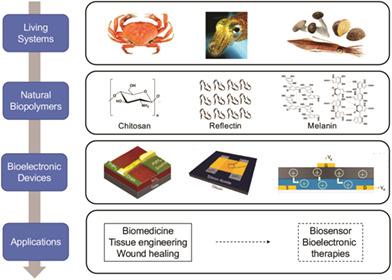当前位置:
X-MOL 学术
›
Biopolymers
›
论文详情
Our official English website, www.x-mol.net, welcomes your feedback! (Note: you will need to create a separate account there.)
Natural biopolymers as proton conductors in bioelectronics
Biopolymers ( IF 2.9 ) Pub Date : 2021-05-22 , DOI: 10.1002/bip.23433 Manping Jia 1 , Jinhwan Kim 1 , Tiffany Nguyen 1, 2 , Thi Duong 1, 3 , Marco Rolandi 1
Biopolymers ( IF 2.9 ) Pub Date : 2021-05-22 , DOI: 10.1002/bip.23433 Manping Jia 1 , Jinhwan Kim 1 , Tiffany Nguyen 1, 2 , Thi Duong 1, 3 , Marco Rolandi 1
Affiliation

|
Bioelectronic devices sense or deliver information at the interface between living systems and electronics by converting biological signals into electronic signals and vice-versa. Biological signals are typically carried by ions and small molecules. As such, ion conducting materials are ideal candidates in bioelectronics for an optimal interface. Among these materials, ion conducting polymers that are able to uptake water are particularly interesting because, in addition to ionic conductivity, their mechanical properties can closely match the ones of living tissue. In this review, we focus on a specific subset of ion-conducting polymers: proton (H+) conductors that are naturally derived. We first provide a brief introduction of the proton conduction mechanism, and then outline the chemical structure and properties of representative proton-conducting natural biopolymers: polysaccharides (chitosan and glycosaminoglycans), peptides and proteins, and melanin. We then highlight examples of using these biopolymers in bioelectronic devices. We conclude with current challenges and future prospects for broader use of natural biopolymers as proton conductors in bioelectronics and potential translational applications.
中文翻译:

天然生物聚合物作为生物电子学中的质子导体
生物电子设备通过将生物信号转换为电子信号(反之亦然),在生命系统和电子设备之间的界面上感知或传递信息。生物信号通常由离子和小分子携带。因此,离子导电材料是生物电子学中最佳界面的理想候选材料。在这些材料中,能够吸收水的离子导电聚合物特别令人感兴趣,因为除了离子导电性之外,它们的机械性能可以与活组织的机械性能密切匹配。在这篇综述中,我们关注离子导电聚合物的一个特定子集:质子 (H +) 自然衍生的导体。我们首先简要介绍质子传导机制,然后概述具有代表性的质子传导天然生物聚合物的化学结构和性质:多糖(壳聚糖和糖胺聚糖)、肽和蛋白质以及黑色素。然后我们重点介绍在生物电子设备中使用这些生物聚合物的例子。我们总结了在生物电子学和潜在的转化应用中更广泛地使用天然生物聚合物作为质子导体的当前挑战和未来前景。
更新日期:2021-07-23
中文翻译:

天然生物聚合物作为生物电子学中的质子导体
生物电子设备通过将生物信号转换为电子信号(反之亦然),在生命系统和电子设备之间的界面上感知或传递信息。生物信号通常由离子和小分子携带。因此,离子导电材料是生物电子学中最佳界面的理想候选材料。在这些材料中,能够吸收水的离子导电聚合物特别令人感兴趣,因为除了离子导电性之外,它们的机械性能可以与活组织的机械性能密切匹配。在这篇综述中,我们关注离子导电聚合物的一个特定子集:质子 (H +) 自然衍生的导体。我们首先简要介绍质子传导机制,然后概述具有代表性的质子传导天然生物聚合物的化学结构和性质:多糖(壳聚糖和糖胺聚糖)、肽和蛋白质以及黑色素。然后我们重点介绍在生物电子设备中使用这些生物聚合物的例子。我们总结了在生物电子学和潜在的转化应用中更广泛地使用天然生物聚合物作为质子导体的当前挑战和未来前景。



























 京公网安备 11010802027423号
京公网安备 11010802027423号